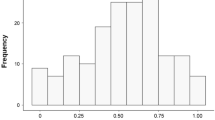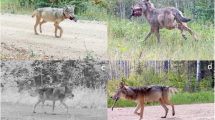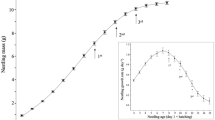Abstract
In altricial birds, parents are assumed to optimize the total food delivery to the brood given the time constraints set by self-feeding and food collecting. Older nestlings may require more food than younger ones, and nestlings may need more energy when their growth rate is higher. By video monitoring prey deliveries in ten nests of the Eurasian Kestrel (Falco tinnunculus), we examined whether parents adjusted feeding effort in relation to nestling age. Based on published data on the growth and energy intake of Kestrel nestlings, we predicted parental prey mass delivery to peak at a nestling age of 15–17 days. The prediction was supported. The decrease in provisioning rate during the later nestling stages was best explained by nestling age. However, we cannot be conclusive as to whether this was caused by a decrease in nestling food demand, or by a seasonal decrease in the availability of voles, the dominant prey. The change in provisioning was mostly an effect of a change in the number of prey items delivered. However, prey size also tended to decrease with increasing nestling age. This is opposite to what has been found in most non-raptorial altricial birds, and may have been caused by the ability of Kestrel parents to dismember large prey and thus overcome the gape size-restricted swallowing capacity of small nestlings, together with a need to provide smaller prey to older nestlings when they start to feed unassisted.
Zusammenfassung
Turmfalkeneltern ( Falco tinnunculus ) passen den Fütterungsaufwand an das Alter ihrer Nestlinge an.
Bei Nesthockern ist die Futterversorgung durch die Eltern entscheidend für Wachstum und Entwicklung der Jungvögel. Man nimmt an, dass die Eltern versuchen, ihrer Brut die in Anbetracht der zeitlichen Beschränkungen, denen sie durch die eigene Nahrungsbeschaffung und die Futtersuche unterliegen, größtmögliche Nahrungsmenge zu beschaffen. Ältere Nestlinge können mehr Nahrung benötigen als jüngere bzw. der Energiebedarf der Nestlinge kann in Phasen stärkeren Wachstums höher sein. Durch Videoaufzeichnung der übergebenen Beutestücke in zehn Turmfalkennestern wurde untersucht, ob die Eltern den Fütterungsaufwand in Abhängigkeit vom Nestlingsalter regulieren. Auf der Grundlage von publizierten Daten zu Wachstum und Energieaufnahme von Turmfalkennestlingen stellten wir die Vermutung auf, dass die Beutelieferungen durch die Eltern bei einem Nestlingsalter von 15–17 Tagen ein Maximum erreichen. Diese Annahme bestätigte sich. Die Abnahme der Versorgungsrate in den späteren Nestlingsstadien ließ sich besser durch das Nestlingsalter als durch die Jahreszeit erklären. Allerdings kann man nicht sicher sagen, ob dies durch eine Abnahme im Nahrungsbedarf der Nestlinge bedingt wurde, oder mit einem jahreszeitlichen Abfall in der Verfügbarkeit von Wühlmäusen, der Hauptbeute, zusammenhing. Die Änderung der Versorgungsmenge wurde hauptsächlich durch eine Änderung in der Anzahl der gelieferten Beutestücke bedingt. Allerdings nahm die Beutegröße mit steigendem Nestlingsalter tendenziell ab. Dies steht im Widerspruch zu den Befunden bei den meisten Nesthockern, die nicht zu den Beutegreifern gehören, und könnte auf die Fähigkeit letzterer zurückzuführen sein, große Beutetiere zu zerlegen und somit das Problem der durch die Rachengröße bedingten begrenzten Schluckkapazität kleiner Nestlinge zu umgehen, in Verbindung mit dem Bedarf an kleineren Beutetieren für ältere Nestlinge, wenn diese selbständig zu fressen beginnen.








Similar content being viewed by others
References
Andersson M, Norberg RÅ (1981) Evolution of reversed sexual size dimorphism and role partitioning among predatory birds, with a size scaling of flight performance. Biol J Linn Soc 15:105–130
Arroyo B, Amar A, Leckie F, Buchanan GM, Wilson JD, Redpath S (2009) Hunting habitat selection by hen harriers on moorland: implications for conservation management. Biol Conserv 142:586–596
Banks RB (1994) Growth and diffusion phenomena: mathematical frameworks and applications. Springer, Berlin
Barba E, Atienzar F, Marin M, Monros JS, Gil-Delgado JA (2009) Patterns of nestling provisioning by a single-prey loader bird, great it Parus major. Bird Study 56:187–197
Blondel J, Dervieux A, Maistre M, Perret P (1991) Feeding ecology and life-history variation of the blue tit in Mediterranean deciduous and sclerophyllous habitats. Oecologia 88:9–14
Bonal R, Aparicio JM (2008) Evidence of prey depletion around lesser kestrel Falco naumanni colonies and its short term negative consequences. J Avian Biol 39:189–197
Burnham KP (2002) Model selection and multimodel inference:a practical information-theoretic approach, 2nd edn. Springer, New York
Burnham KP, Anderson DR (1998) Model selection and inference: a practical information-theoretic approach. Springer, New York
Collopy MW (1984) Parental care and feeding ecology of golden eagle nestlings. Auk 101:753–760
Daan S, Masman D, Strijkstra A, Verhulst S (1989) Intraspecific allometry of basal metabolic rate: relations with body size, temperature, composition, and circadian phase in the kestrel, Falco tinnunculus. J Biol Rhythms 4:155–171
Durant JM, Gendner J-P, Handrich Y (2004) Should I brood or should I hunt: a female barn owl’s dilemma. Can J Zool 82:1011–1016
Erikstad KE, Sandvik H, Fauchald P, Tveraa T (2009) Short- and long-term consequences of reproductive decisions: an experimental study in the puffin. Ecology 90:3197–3208
Fargallo JA, Laaksonen T, Korpimäki E, Pöyri V, Griffith SC, Valkama J (2003) Size-mediated dominance and begging behaviour in Eurasian kestrel broods. Evol Ecol Res 5:549–558
Grundel R (1987) Determinants of nestling feeding rates and parental investment in mountain chickadee. Condor 89:319–328
Hakkarainen H, Koivunen V, Korpimaki E (1997) Reproductive success and parental effort of Tengmalm’s owls: effects of spatial and temporal variation in habitat quality. Ecoscience 4:35–42
Johnsen I, Erikstad KE, Saether BE (1994) Regulation of parental investment in a long-lived seabird, the puffin Fratercula arctica: an experiment. Oikos 71:273–278
Karasov WH (1990) Digestion in birds: chemical and physiological determinants and ecological implications. Stud Avian Biol 13:391–415
Kirkwood JK (1981) Bioenergetics and growth in the kestrel (Falco tinnunculus). PhD thesis, University of Bristol
Korpimäki E (1985) Diet of the kestrel Falco tinnunculus in the breeding season. Ornis Fenn 62:130–137
Korpimaki E (1986) Seasonal changes in the food of the Tengmalm’s owl Aegolius funereus in western Finland. Ann Zool Fenn 23:339–344
Korpimäki E, Norrdahl K (1991) Numerical and functional responses of kestrels, short-eared owls, and long-eared owls to vole densities. Ecology 72:814–826
Lewis SB, Falter AR, Titus K (2004) A comparison of 3 methods for assessing raptor diet during the breeding season. Wildl Soc Bull 32:373–385
Mägi M, Mänd R, Tamm H, Sisask E, Kilgas P, Tilgar V (2009) Low reproductive success of great yits in the preferred habitat: a role of good availability. Ecoscience 16:145–157
Masman D, Gordijn M, Daan S, Dijkstra C (1986) Ecological energetics of the kestrel—field estimates of energy-intake throughout the year. Ardea 74:24–39
Masman D, Dijkstra C, Daan S, Bult A (1989) Energetic limitation of avian parental effort—field experiments in the kestrel (Falco tinnunculus). J Evol Biol 2:435–455
Mauck RA, Grubb JTC (1995) Petrel parents shunt all experimentally increased reproductive costs to their offspring. Anim Behav 49:999–1008
Mock DW, Parker GA (1997) The evolution of sibling rivalry. Oxford University Press, Oxford
Naef-Daenzer B, Keller LF (1999) The foraging performance of great and blue tits (Parus major and P. caerulens) in relation to caterpillar development, and its consequences for nestling growth and fledging weight. J Anim Ecol 68:708–718
Naef-Daenzer L, Naef-Daenzer B, Nager RG (2000) Prey selection and foraging performance of breeding great tits Parus major in relation to food availability. J Avian Biol 31:206–214
Navarro J, Gonzàlez-Solìs J (2007) Experimental increase of flying costs in a pelagic seabird: effects on foraging strategies, nutritional state and chick condition. Oecologia 151:150–160
Newton I (1979) Population ecology of raptors. Poyser, Berkhamsted
Pinheiro JC, Bates DM (2000) Mixed-effects models in S and S-PLUS. Springer, New York
R Development Core Team (2010) R: a language and environment for statistical computing. Austria, Vienna
Reid WV (1987) The cost of reproduction in the glaucous-winged gull. Oecologia 74:458–467
Ricklefs RE (1987) Response of adult leach’s storm-petrels to increased food demand at the nest. Auk 104:750–756
Selander RK (1966) Sexual dimorphism and differential niche utilization in birds. Condor 68:113–151
Slagsvold T, Sonerud GA (2007) Prey size and ingestion rate in raptors: importance for sex roles and reversed sexual size dimorphism. J Avian Biol 38:650–661
Slagsvold T, Wiebe KL (2007) Hatching asynchrony and early nestling mortality: the feeding constraint hypothesis. Anim Behav 73:691–700
Snyder NFR, Wiley JW (1976) Sexual size dimorphism in hawks and owls of North America. Ornithol Monog 20
Steen R (2009) A portable digital video surveillance system to monitor prey deliveries at raptor nests. J Raptor Res 43:69–74
Steen R (2010) Food provisioning in a generalist predator: selecting, preparing, allocating and feeding prey to nestlings in the Eurasian kestrel (Falco tinnunculus). PhD thesis, Norwegian University of Life Sciences, Ås
Steen R, Løw LM, Sonerud GA, Selås V, Slagsvold T (2010) The feeding constraint hypothesis: prey preparation as a function of nestling age and prey mass in the Eurasian kestrel. Anim Behav 80:147–153
Steen R, Løw LM, Sonerud GA (2011a) Delivery of common lizards (Zootoca (Lacerta) vivipara) to nests of Eurasian kestrels (Falco tinnunculus) determined by solar height and ambient temperature. Can J Zool 89:199–205
Steen R, Løw LM, Sonerud GA, Selås V, Slagsvold T (2011b) Prey delivery rates as estimates of prey consumption by Eurasian kestrel (Falco tinnunculus) nestlings. Ardea 99:1–8
Stirling JR, Zakynthinaki M (2008) The point of maximum curvature as a marker for physiological time series. J Nonlinear Math Phys 15:396–406
Temeles EJ (1985) Sexual size dimorphism of bird-eating hawks: the effect of prey vulnerability. Am Nat 125:485–499
Tremblay I, Thomas D, Blondel J, Perret P, Lambrechts MM (2005) The effect of habitat quality on foraging patterns, provisioning rate and nestling growth in corsican blue yits Parus caeruleus. Ibis 147:17–24
Trivers RL (1974) Parent-offspring conflict. Am Zool 14:249–264
Tryjanowski P, Hromada M (2005) Do males of the great grey shrike, Lanius excubitor, trade food for extrapair copulations? Anim Behav 69:529–533
Village A (1990) The kestrel. Poyser, London
Weimerskirch H, Chastel O, Ackermann L (1995) Adjustment of parental effort to manipulated foraging ability in a pelagic seabird, the thin-billed prion Pachyptila belcheri. Behav Ecol Sociobiol 36:11–16
Ydenberg RC (2007) Provisioning. In: Stephens DW, Brown JS, Ydenberg RC (eds) Foraging behavior and ecology. University of Chicago Press, Chicago, pp 273–304
Zarybnicka M, Sedlacek O, Korpimäki E (2009) Do Tengmalm’s owls alter parental feeding effort under varying conditions of main prey availability? J Ornithol 150:231–237
Acknowledgments
We thank Bjørn E. Foyn and Ole Petter Blestad for allowing us to film their Kestrel nest boxes, Geir A. Homme for help with the field work, Patricia L. Kennedy, Vidar Selås, Peter Sunde, and two anonymous referees for comments on the manuscript, Harry P. Andreassen for statistical advice, and Grethe Hillersøy for improving the English. The study was supported by the Directorate for Nature Management and the Hedmark County Governor.
Author information
Authors and Affiliations
Corresponding author
Additional information
Communicated by T. Friedl.
Electronic supplementary material
Below is the link to the electronic supplementary material.
Supplementary material 1 (WMV 2286 kb)
Rights and permissions
About this article
Cite this article
Steen, R., Sonerud, G.A. & Slagsvold, T. Parents adjust feeding effort in relation to nestling age in the Eurasian Kestrel (Falco tinnunculus). J Ornithol 153, 1087–1099 (2012). https://doi.org/10.1007/s10336-012-0838-y
Received:
Revised:
Accepted:
Published:
Issue Date:
DOI: https://doi.org/10.1007/s10336-012-0838-y




